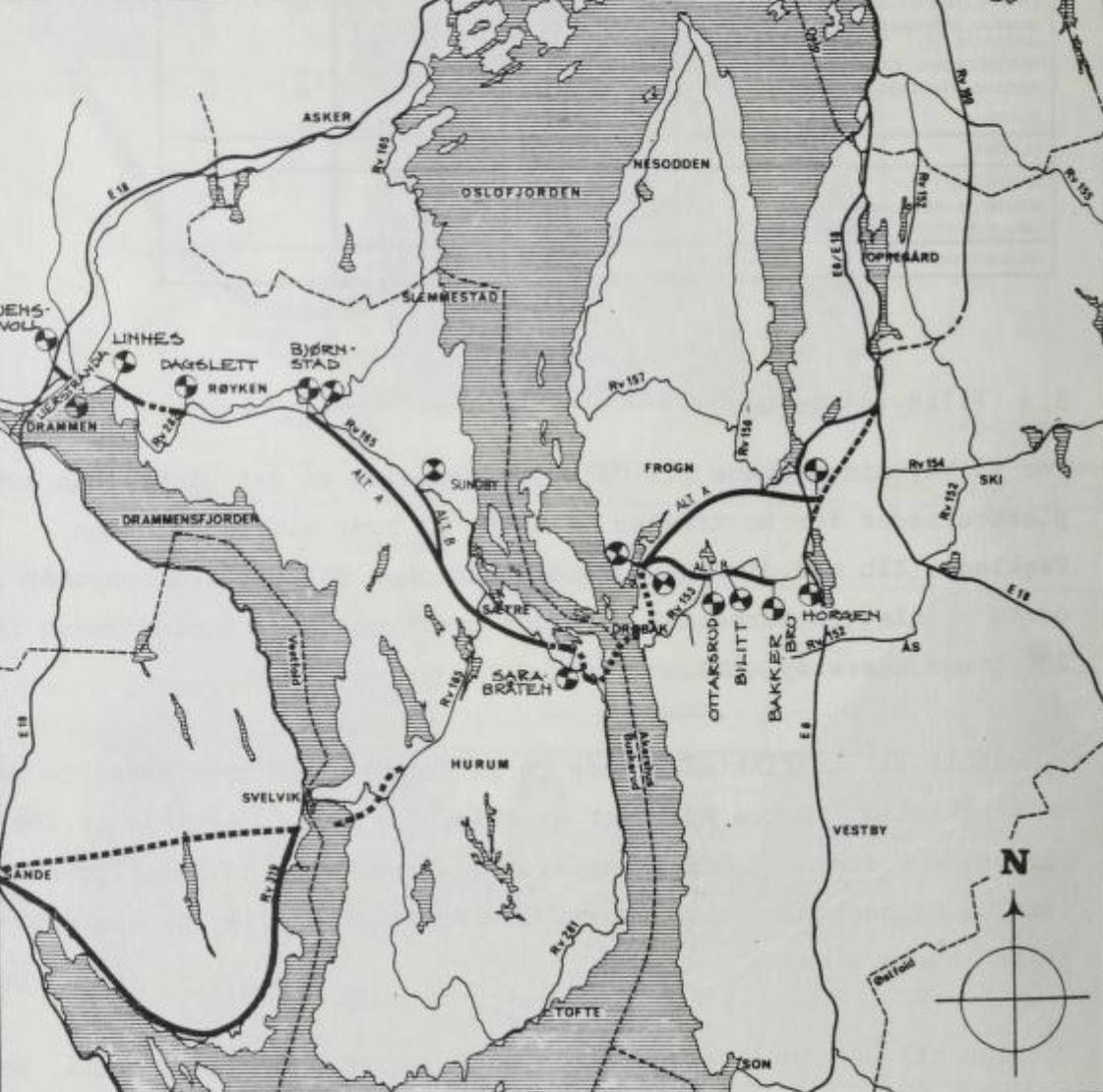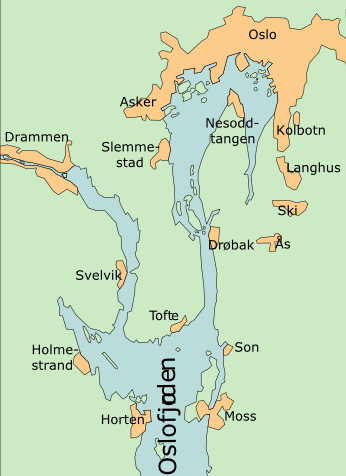|
Spikkestad
Spikkestad is a village in the municipality of Asker, in the province of Viken, Norway. Its current population (2022) is between 4000 and 5000. Spikkestad is located in the northern part of the peninsula of Hurumlandet, closer to the Drammensfjord than the Oslo Fjord. Spikkestad railway station was opened in 1885 to link Asker to Drammen. The village was named after the farm "Spikkestad", as the station was built on its lands. In the early 1970s, the Lieråsen tunnel was built 3 km to the North-West of the village, which made the trip between Oslo and Drammen much shorter. The segment of the train track between Spikkestad and Drammen was closed after the tunnel opened. Spikkestad thus became the terminus of Spikkestadbanen. However, there are still trains running between Asker and Spikkestad, every half-hour. Spikkestad is also well connected by road. The Norwegian National Road 23 (now European highway E134) runs through the outskirts of the village and the road provide ... [...More Info...] [...Related Items...] OR: [Wikipedia] [Google] [Baidu] |
Spikkestad Station
Spikkestad Station ( no, Spikkestad stasjon) is a railway station located at Spikkestad in Røyken, Norway, and is the terminus of the Spikkestad Line. It was opened as part of the Drammen Line on 3 February 1885, but in 1973 the new Lieråsen Tunnel opened through Lieråsen, and the old part of the Drammen Line became a commuter train line with Spikkestad, which is today is primarily a residential town, as its western terminus. The station is served by a half-hourly service of commuter trains running to Asker, Sandvika, and Oslo Central Station (journey time: 52 minutes) and then on to Lillestrøm Lillestrøm is a municipality in Viken county. It is located in the traditional district of Romerike. With a population of 85,757 inhabitants, it is the fourth most populated municipality in Viken. It was founded on 1 January 2020 as a merger .... The old station building, which was originally built to serve Høvik and was moved from there in 1922, today stands a hundred metres ... [...More Info...] [...Related Items...] OR: [Wikipedia] [Google] [Baidu] |
Spikkestadbanen
The Spikkestad Line () is a 14 kilometre long railway line between Asker and Spikkestad in Norway. It was originally part of the Drammen Line between Oslo and Drammen which was built in 1872. In 1973, Lieråsen Tunnel was built to shorten the Drammen Line, and much of the old line was closed down. The last train on the section between Spikkestad and Drammen ran 2 June 1973. However, the stretch between Asker and Spikkestad was kept as a branch line A branch line is a phrase used in railway terminology to denote a secondary railway line which branches off a more important through route, usually a main line. A very short branch line may be called a spur line. Industrial spur An industr ... for local commuter traffic. Pictures of stations on Spikkestadbanen Image:Asker railway station TRS 061028 031.jpg, Asker station Image:Gullhella train stop TRS 061107 009.jpg, Gullhella train stop Image:NSB type 69 ved Heggedal stasjon TRS 061023 001.jpg, Heggedal station Image:Rø ... [...More Info...] [...Related Items...] OR: [Wikipedia] [Google] [Baidu] |
Lieråsen Tunnel
Lieråsen Tunnel is a single-tubed railway tunnel of the Drammen Line situated in Asker, Røyken and Lier in Norway. At a length of , the double track tunnel is located immediately between Asker Station and Lier Station. It is used for a mix of short- and long-haul passenger trains and freight trains. Construction of the tunnel commenced in 1962, along with a new section of track between the tunnel and Brakerøya Station. Inadequate geological surveys ahead of construction resulted in the tunnel being built in the middle of an altered and crushed zone, delaying construction and eventually shifting the route to the southwest. The tunnel opened on 3 June 1973. In addition to providing double track, it shortened the Drammen Line by . Part of the old section of the Drammen Line became the Spikkestad Line, while the rest of line was closed. Lieråsen was the longest railway tunnel in the country until the Romerike Tunnel opened in 1999. Specifications The Lieråsen Tunnel i ... [...More Info...] [...Related Items...] OR: [Wikipedia] [Google] [Baidu] |
Norwegian National Road 23
National Road 23 ( no, Riksvei 23), also known as the Oslofjord Link (Norwegian: ), was the name of a largely limited-access road which connects the municipalities of Lier, Røyken, Hurum and Frogn in Norway. The Oslofjord Tunnel causes the road to acts as the only fixed link crossing of the Oslofjord and makes that section subject to tolls. In 2018 the road was renamed into European route E134. History Planning National Road 23 is the result of the need for an auxiliary road to support a fixed link crossing of the Oslofjord. Since 1939 this crossing was carried out by the Drøbak–Storsand Ferry, a service operated by Bilferjen Drøbak–Hurum. The ferry had a daily traffic of 320 vehicles in 1980. A fixed crossing of Hurumlandet and the Oslofjord was first proposed by Anton Grønsand in 1958.Messel (2004): 429 It was followed up in a regional transport plan published in 1963, with a horizon of forty years. Road planning was in the following decade reorganised so that mo ... [...More Info...] [...Related Items...] OR: [Wikipedia] [Google] [Baidu] |
Gullaug
Gullaug is an unincorporated village at Lier municipality in Buskerud, Norway. Gullaug is located between Lierbyen, Røyken and Drammen. Geographically, Gullaug is an area that encompasses little more than a small commercial area and local shops, but locals apply the label to the entire area stretching from Lierkroa in the north, Lahell Lahell is a village in the municipality of Lier in Buskerud, Norway. Located in the south of the municipality of Lier, southwest of Spikkestad in Røyken, it is neighbouring to the urban area Drammen which bordering to Lier. Norwegian National ... in the south, Amtmandsvingen in the east and Spikkestad in the west. This is the area that is served by the Gullaug school. Gullaug Church (''Gullaug kirke'') in Frogner parish dates from 1905 and was constructed of wood. It has seating for 100 people. Gullaug holdeplass was a railroad stop on the Drammen Line. It opened in 1956 and closed in 1973 when Lieråsen Tunnel opened and the rai ... [...More Info...] [...Related Items...] OR: [Wikipedia] [Google] [Baidu] |
Elopak
Elopak is a Norwegian company producing cartons for liquids, starting with aseptic gable top cartons for milk. The company was founded in 1957 by Johan Henrik Andresen and Christian August Johansen as a European licensee of Pure-Pak,Elopak AS Store Norske Leksikon
The ''Great Norwegian Encyclopedia'' ( no, Store Norske Leksikon, abbreviated ''SNL''), is a Norwegian-language online encyclopedia.
The online encyclopedia is among the most-read Norwegian published sites, with more than two million unique vis ... , retrieved 4 April 2013 the Elopak name standing for ''European License Of PURE-PAK''. In 1987, Elopak bought the Ex-Cell-O Packaging Systems Division from which it was original ...
[...More Info...] [...Related Items...] OR: [Wikipedia] [Google] [Baidu] |
Villages In Asker
A village is a clustered human settlement or community, larger than a hamlet but smaller than a town (although the word is often used to describe both hamlets and smaller towns), with a population typically ranging from a few hundred to a few thousand. Though villages are often located in rural areas, the term urban village is also applied to certain urban neighborhoods. Villages are normally permanent, with fixed dwellings; however, transient villages can occur. Further, the dwellings of a village are fairly close to one another, not scattered broadly over the landscape, as a dispersed settlement. In the past, villages were a usual form of community for societies that practice subsistence agriculture, and also for some non-agricultural societies. In Great Britain, a hamlet earned the right to be called a village when it built a church. [...More Info...] [...Related Items...] OR: [Wikipedia] [Google] [Baidu] |
Villages In Viken (county)
A village is a clustered human settlement or Residential community, community, larger than a hamlet (place), hamlet but smaller than a town (although the word is often used to describe both hamlets and smaller towns), with a population typically ranging from a few hundred to a few thousand. Though villages are often located in rural areas, the term urban village is also applied to certain urban neighborhoods. Villages are normally permanent, with fixed dwellings; however, transient villages can occur. Further, the dwellings of a village are fairly close to one another, not scattered broadly over the landscape, as a dispersed settlement. In the past, villages were a usual form of community for societies that practice subsistence agriculture, and also for some non-agricultural societies. In Great Britain, a hamlet earned the right to be called a village when it built a Church (building), church. [...More Info...] [...Related Items...] OR: [Wikipedia] [Google] [Baidu] |
Slemmestad
Slemmestad is a village in Røyken in Asker municipality in Viken, Norway. Slemmestad is located on the west bank of the Oslofjord, west of Oslo. History Historically Slemmestad was located on the old highway running between Oslo and Drammen. Until the establishment of cement factory in 1892, this was a pure farming village. The largest farms were the Lillelien, together with øvre and nedre Slemmestad. Slemmestad was built around the Aktieselskabet Christiania Portland Cementfabrik cement plant. Aktieselskabet Christiania Portland Cementfabrik, later Slemmestad sementfabrikk, was in operation from 1893 to 1989. The company was for many years the principal manufacturer of cement within Norway. The factory was rebuilt several times with new and more modern cement kilns. Cement production peaked in 1973, when it produced 1,082,677 tons. Geography Slemmestad forms part of the Oslo Geological Region (''Oslofeltet''). This is an ancient, sunken part of the crust reaching in ... [...More Info...] [...Related Items...] OR: [Wikipedia] [Google] [Baidu] |
Viking Era
The Viking Age () was the period during the Middle Ages when Norsemen known as Vikings undertook large-scale raiding, colonizing, conquest, and trading throughout Europe and reached North America. It followed the Migration Period and the Germanic Iron Age. The Viking Age applies not only to their homeland of Scandinavia but also to any place significantly settled by Scandinavians during the period. The Scandinavians of the Viking Age are often referred to as ''Vikings'' as well as ''Norsemen'', although few of them were Vikings in sense of being engaged in piracy. Voyaging by sea from their homelands in Denmark, Norway, and Sweden, the Norse people settled in the British Isles, Ireland, the Faroe Islands, Iceland, Greenland, Normandy, and the Baltic coast and along the Dnieper and Volga trade routes in eastern Europe, where they were also known as Varangians. They also briefly settled in Newfoundland, becoming the first Europeans to reach North America. The Norse ... [...More Info...] [...Related Items...] OR: [Wikipedia] [Google] [Baidu] |
Industrialization
Industrialisation ( alternatively spelled industrialization) is the period of social and economic change that transforms a human group from an agrarian society into an industrial society. This involves an extensive re-organisation of an economy for the purpose of manufacturing. Historically industrialization is associated with increase of polluting industries heavily dependent on fossil fuels. With the increasing focus on sustainable development and green industrial policy practices, industrialization increasingly includes technological leapfrogging, with direct investment in more advanced, cleaner technologies. The reorganization of the economy has many unintended consequences both economically and socially. As industrial workers' incomes rise, markets for consumer goods and services of all kinds tend to expand and provide a further stimulus to industrial investment and economic growth. Moreover, family structures tend to shift as extended families tend to no longer l ... [...More Info...] [...Related Items...] OR: [Wikipedia] [Google] [Baidu] |







